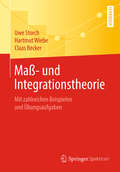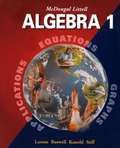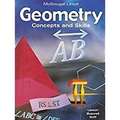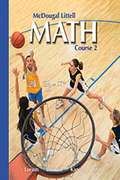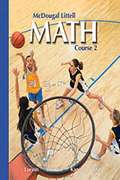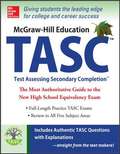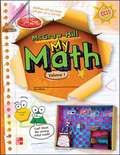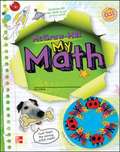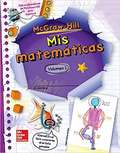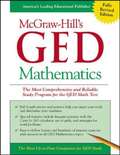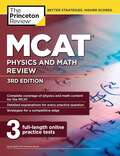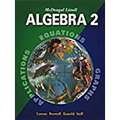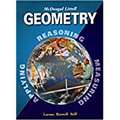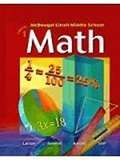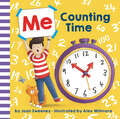- Table View
- List View
Maß- und Integrationstheorie: Mit zahlreichen Beispielen und Übungsaufgaben
by Uwe Storch Hartmut Wiebe Claas BeckerIn diesem Lehrbuch wird die klassische Lebesguesche Maß- und Integrationstheorie stringent entwickelt und dargestellt – trotz großem Tiefgang ist das Buch dadurch gut lesbar. Die einzelnen Abschnitte werden außerdem durch zahlreiche Beispiele und Aufgaben illustriert und ergänzt. Das Buch ist somit sowohl zum Selbststudium als auch als Nachschlagewerk sehr gut geeignet. Grundkenntnisse aus Mengenlehre und Analysis sowie gelegentlich auch Linearer Algebra und Topologie werden vorausgesetzt. Bei Bedarf können diese in den beiden Büchern Grundkonzepte der Mathematik und Analysis einer Veränderlichen der Autoren U. Storch und H. Wiebe nachgelesen werden.
McDougal Littell Geometry: Concepts and Skills
by Ron Larson Laurie Boswell Lee StiffTextbook on geometry.
McDougal Littell Math (Course 1 #2)
by Ron Larson Laurie Boswell Lee Stiff Timothy D. KanoldThe book covers a vast range of topics like rational numbers, operations,equations and functions, geometry, square roots, and probability and provides instruction and practice on standardized test questions in many formats.
McDougal Littell Middle School Math: Course 2
by Ron Larson Laurie BoswellMiddle school math textbook
McGraw-Hill Education TASC - Test Accessing Secondary Completion
by Kathy A. ZahlerIt's packed with everything you need to succeed on the test---and get the high school credential you want. Only this guide can show you exactly what to expect on the test, tell you how the test is scored, and give you authentic TASC questions for practice. That makes this bestselling guide your most reliable and accurate source for everything you need to know about the TASC.
McGraw-Hill My Math, Grade 3, Volume 1
by McGraw-Hill EducationThis set provides the consumable Student Edition, Volume 1, which contains everything students need to build conceptual understanding, application, and procedural skill and fluency with math content organized to address CCSS. Students engage in learning with write-in text on vocabulary support and homework pages, and real-world problem-solving investigations.
McGraw-Hill My Math, Grade 4, Volume 1
by McGraw-Hill EducationThis set provides the consumable Student Edition, Volume 1, which contains everything students need to build conceptual understanding, application, and procedural skill and fluency with math content organized to address CCSS. Students engage in learning with write-in text on vocabulary support and homework pages, and real-world problem-solving investigations.
McGraw-Hill My Math, Grade 5, Spanish Student Edition, Volume 1 (Elementary Math Connects)
by McGraw Hill Education StaffNIMAC-sourced textbook
McGraw-Hill's GED Mathematics: The Most Comprehensive and Reliable Study Program for the GED Math Test
by Jerry HowettMcGraw-Hill's GED Mathematics guides you through the GED preparation process step-by-step. A Pretest helps you determine your strengths and weaknesses so you can create a study plan to fit your needs. The following chapters introduce you to math concepts on which hundreds of GED questions are based. Then check your understanding of these ideas with the Posttest, presented in the GED format. You can then see how ready you are for the big exam by taking the full-length Practice Test. McGraw-Hill's GED Mathematics includes: *Clear instructions to show you how to use number grids and coordinate plane grids. *Instruction and frequent practice with the Casio /x-260 calculator. *Problem-solving strategies to help you understand word problems. *Easy-to-follow lessons to develop essential math skills in whole numbers, decimals, fractions, percents, ratios, data analysis, geometry, and algebra.
Mcat Physics And Math Review, 3rd Edition
by The Princeton The Princeton ReviewMCAT Physics and Math Review, 3rd Edition (Graduate School Test Preparation)
Mcdougal Littell Algebra 2: Pupil's Edition
by Ron Larson Laurie Boswell Lee Stiff Timothy D. KanoldAlgebra 2 brings math to life with many real-life applications. Circling the globe are three key aspects of Algebra 2--the equations, graphs, and applications that you will use in this course. They will help you understand how mathematics relates to the world. As you explore the applications presented in the book, try to make your own connections between mathematics and the world around you!
Mcdougal Littell Geometry: Applying, Reasoning, Measuring
by Ron Larson Laurie Boswell Lee StiffGeometry, like much of mathematics and science, developed when people began recognizing and describing patterns. In this course, you will study many amazing patterns that were discovered by people throughout history and all around the world. You will also learn to recognize and describe patterns of your own. Sometimes, patterns allow you to make accurate predictions.
Mcdougal Littell Middle School Math: Course 1
by Larson McDougal-Littell Publishing StaffMcDougal Littell Middle School Math, Course 1
Me Counting Time
by Joan SweeneyHow long is a minute? What is a decade? How many decades are in a century?Now with new illustrations by Alex Willmore, Me Counting Time is a playful introduction to the concept of time. When a young boy prepares for his seventh birthday and counts how many years old he is, he begins on an exploration of the many units of time that are a part of everyday life. Fun to read, easy to understand, and brimming with colorful illustrations, this title joins the other repackages in Joan Sweeney's popular Me...series--Me on the Map, Me and My Place in Space, Me and My Amazing Body, Me and My Family Tree, Me and the Measure of Things, and Me and My Senses.
